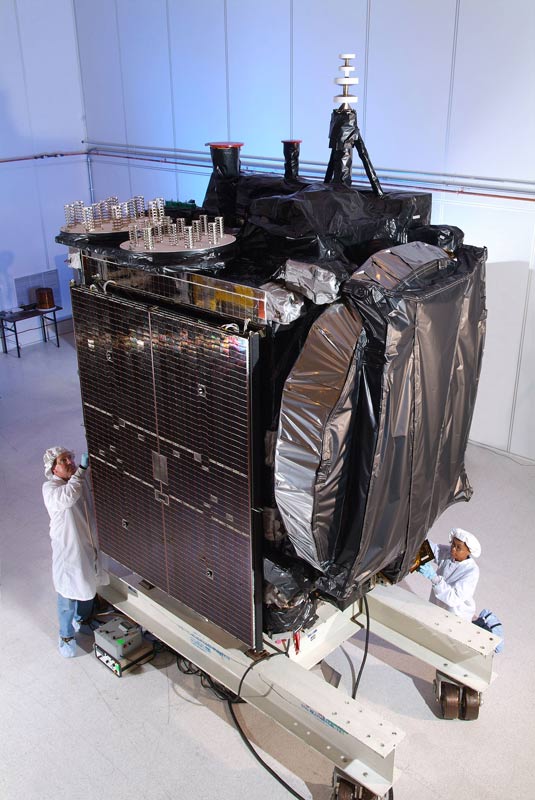Zombie Satellite Galaxy 15 Still Won't Die

A waywardsatellite that has spent months drifting in orbit has not shut itself down as originallypredicted, and continues to pose a signal interference risk for other craft.
Theso-called "zombiesatellite," Intelsat's Galaxy 15 communications satellite, lostcontact with ground controllers in April, but continues to follow a stable path asits operators on Earth work to avoid potential interference with other nearbyspacecraft.
In anunprecedented satellite malfunction, the telecommunications broadcast packageon Galaxy15 is stuck on and still transmits signals, but ground controllers are unable to control the solar-powered craft.Intelsat engineers initially estimated that the satellite would lose power and shutitself off in late August, but so far, that has not happened.
"It hasnot powered down yet, and it continues to drift ? but, we still know where it'sgoing, and it's still following a predictable path," Intelsat spokesman NickMitsis told SPACE.com.
The team's mainfocus is preventing Galaxy 15's signals from interfering with neighboringsatellites, since Intelsat officials have said there is no risk of itphysically colliding with other spacecraft.? [WorstSpace Debris Moments in History]
How itall started
The4,171-pound (1,892-kg) satellite went rogue on April 5, when it stoppedresponding to controllers on the ground. Intelsat has been investigating thecause of the glitch, including the possibilityof a solar storm interference.
Breaking space news, the latest updates on rocket launches, skywatching events and more!
Following the anomaly, the spacecraft started veering off its assigned orbital slot of 133 degrees west longitude,22,000 miles (36,000 km) over the equator, yet the "zombie satellite"maintained an active payload, with its C-band telecommunications transmitter stillfunctioning.
At the moment,Galaxy 15 is drifting close to the orbit of Mexico's Satmex 5 communicationssatellite, and will make its closest approach on Sept. 21.
"We'reworking with Satmex and sharing the Galaxy 15 information that we have rightnow," Mitsis said. "We're relaying lessons learned from previousflyby sessions and offering recommendations for Satmex to support theirmaneuver."
Mostrecently, Intelsat engineers assisted Telesat, a satellite services providerheadquartered in Ottawa, Canada, as Galaxy 15 swooped by the Canadian Anik F3satellite. The flyby was completed safely without any signal interruption onSept. 14.
Before that, Intelsatoversaw four other flybys of satellites in its own fleet, including Galaxy 13and 14.
In May, thesatellite operator SES World Skies ? whose AMC-11 satellite passed nearGalaxy15's path at the time ? worked with Intelsat to successfully perform a seriesof intricate maneuvers to avoid interference and service interruptions.
Whatcomes next
Severalattempts to shut down Galaxy 15 have been unsuccessful, leaving the defunctsatellite stuck drifting in the cosmos.
Ultimately, thesatellite is expected to lose its Earth-pointing capability. Once this lock onEarth is lost and its solar panels will no longer be pointed at the sun, thesatellite's battery power will eventually die.
"Withoutpower, the satellite would not be able to cause any interference," Mitsissaid. "It will power down, shut off, and if it doesn't reboot, then itwill become space debris."
There are about500,000 known pieces of orbiting space junk. Of those, about 21,000 objects arelarger than 4 inches (10.1 cm) in diameter, and are being tracked by theDepartment of Defense's U.S. Space Surveillance Network. These are items likespent rocket stages and broken satellites such as Galaxy 15.
Space debris? even tiny pieces of it ? can be dangerous because they orbit the Earth athigh speeds and pose risks for impacts and collisions.
Galaxy 15launched on Oct. 13, 2005 on a European Ariane rocket. The spacecraft'smanufacturer, Orbital Sciences Corp. of Virginia, has said that an intensesolar storm in early April may have caused the breakdown in communication.
Meanwhile,Intelsat continues its own technical investigation, but has yet to reach anydefinitive conclusions on the cause of the glitch.
"Thiscontinues to be an unprecedented event for the entire industry," Mitsissaid. "The good news is, we haven't had channel losses, we haven't hadprogramming losses, and we're very thankful for the cooperation we're gettingfrom our satellite neighbors."
- Worst Space Debris Moments in History
- Images - Spotting Satellites andSpaceships From Earth
- Life's Little Mysteries: How MuchJunk is in Space?

Denise Chow is a former Space.com staff writer who then worked as assistant managing editor at Live Science before moving to NBC News as a science reporter, where she focuses on general science and climate change. She spent two years with Space.com, writing about rocket launches and covering NASA's final three space shuttle missions, before joining the Live Science team in 2013. A Canadian transplant, Denise has a bachelor's degree from the University of Toronto, and a master's degree in journalism from New York University. At NBC News, Denise covers general science and climate change.
